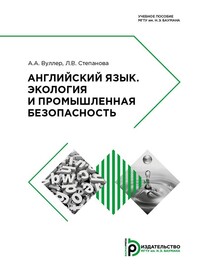Английский язык. Экология и промышленная безопасность
Покупка
Тематика:
Английский язык
Год издания: 2019
Кол-во страниц: 56
Дополнительно
Вид издания:
Учебное пособие
Уровень образования:
ВО - Бакалавриат
ISBN: 978-5-7038-5066-4
Артикул: 840485.01.99
Издание содержит оригинальные тексты, сообщения из англоязычной прессы на актуальные темы экологии. Задания направлены на закрепление лексико-грамматического материала. Различные упражнения помогут
сформировать у обучающихся навыки монологической и диалогической речи по тематике «Экология». Для студентов старших курсов, обучающихся по направлению подготовки «Техносферная безопасность» в технических университетах.
Тематика:
ББК:
УДК:
ОКСО:
- ВО - Бакалавриат
- 20.03.01: Техносферная безопасность
- ВО - Магистратура
- 20.04.01: Техносферная безопасность
ГРНТИ:
Скопировать запись
Фрагмент текстового слоя документа размещен для индексирующих роботов
Английский язык. Экология и промышленная безопасность Учебное пособие А.А. Вуллер, Л.В. Степанова Федеральное государственное бюджетное образовательное учреждение высшего образования «Московский государственный технический университет имени Н.Э. Баумана (национальный исследовательский университет)»
УДК 81:378(075) ББК 81.2 Англ В88 Издание доступно в электронном виде по адресу ebooks.bmstu.press/catalog/107/book1938.html Факультет » Кафедра «Английский язык для машиностроительных специальностей» Рекомендовано Научно-методическим советом МГТУ им. Н.Э. Баумана в качестве учебного пособия Вуллер, А. А. В88 Английский язык. Экология и промышленная безопас- ность : учебное пособие / А. А. Вуллер, Л. В. Степанова. — Москва : Издательство МГТУ им. Н. Э. Баумана, 2019. — 50, [6] с. ISBN 978-5-7038-5066-4 Издание содержит оригинальные тексты, сообщения из англоязычной прессы на актуальные темы экологии. Задания направлены на закрепление лексико-грамматического материала. Различные упражнения помогут сформировать у обучающихся навыки монологической и диалогической речи по тематике «Экология». Для студентов старших курсов, обучающихся по направлению подготовки «Техносферная безопасность» в технических университетах. УДК 81:378(075) ББК 81.2 Англ © МГТУ им. Н.Э. Баумана, 2019 © Оформление. Издательство ISBN 978-5-7038-5066-4 МГТУ им. Н.Э. Баумана, 2019 «Лингвистика
Предисловие Издание разработано преподавателями кафедры «Английс- кий язык для машиностроительных специальностей» МГТУ им. Н.Э. Баумана в соответствии с современными требованиями федерального государственного образовательного стандарта по курсу «Иностранный язык для технических вузов». Учебное пособие предназначено для работы на семинарских занятиях по английскому языку со студентами старших курсов технических университетов. Цель пособия — обогащение словарного запаса и развитие коммуникативных навыков обучающихся в университете по направлению подготовки 20.00.00 «Техносферная безопасность». В учебном пособии рассмотрены актуальные вопросы по теме «Экология», изучаемые студентами в рамках своей специальности. Расширению кругозора студентов помогут задания, непосредственно связанные с современными проблемами экологической безопасности и защиты окружающей среды. Пособие состоит из четырех основных модулей (Water Pollution, Air Pollution, Noise Pollution, Safety Engineering) и одного дополнительного Around The World, содержащего тексты для самостоятельного чтения и обсуждения в аудитории. В каждый модуль включены аутентичные тексты по конкретным разделам промышленной экологии, введена основная лексика (тематический словарь), лексические и коммуникативные упражнения, задания для развития навыков устной и письменной речи. Лексика модулей и разработанные авторами книги упражнения способствуют формированию межпредметных связей, развитию интереса и творческого подхода студентов к изучению английского языка и предметов их профессиональной ориентации. Построение данного пособия соответствует современным требованиям к преподаванию иностранного языка. Коммуникативная
направленность в обучении английскому языку базируется на таких принципах, как активное участие студентов в видах деятельности, которые имитируют реальные ситуации для принятия решения, выражения собственных взглядов по изучаемой теме в совместной работе студентов, в ходе проведения круглых столов, на презентациях и в дискуссиях. Практическая значимость учебного пособия заключается в формировании коммуникативной компетенции студентов по перечисленным выше темам. Формированию этой компетенции способствует преобладание в издании проблемно-речевых и творческих упражнений, использование ролевых игр для создания ситуаций общения, для быстрого реагирования в процессе коммуникации, для психологической готовности к реальному общению на английском языке в различных профессиональных ситуациях. Задания и упражнения охватывают основные вопросы по теме «Экология». Материал учебного пособия может быть использован в качестве основного в курсе изучения английского языка по направлению подготовки «Техносферная безопасность» или в качестве дополнительного — при обучении английскому языку студентов других технических специальностей.
Unit 1. Water Pollution Words to remember: contamination — загрязнение wastes — отходы to discharge — выбрасывать to render — становиться, делать to signify — означать lake — озеро stream — ручей sewage — сточные воды effluent — поток, сток acid — кислота alkali — щелочь grease — жир dye — краситель to dissolve — растворять suspended — взвешенный (о частицах) mercury — ртуть lead — свинец sulfur — сера to assess — оценивать sodium — натрий arsenic — мышьяк liver — печень to facilitate — облегчать qualitative — качественный quantitative — количественный to enhance — повышать to implement — внедрять
1. Match the words to their definition. a wastes b to dissolve c lake d contamination e to assess f to signify g effluent h to discharge i dye j criteria k to classify 1 a substance used for changing a colour 2 to mean or to be a symbol of something 3 useless materials, substances or parts, that are left after using something 4 a large body of water surrounded by land 5 liquid waste or sewage from a factory 6 to let liquid or gas leave 7 to make a mixture of a substance into a liquid 8 standards that are used for judging smth 9 to consider a situation or a problem 10 carefully, to calculate 11 to put people or things into particular groups 2. Find the synonyms, match them. 1 contamination 2 grease 3 stream 4 to dissolve 5 to assess 6 to facilitate 7 to enhance 8 to implement 9 to discharge 10 to signify 11 to render a to ease b to mean c a small river d to mix into the liquid e to estimate f to improve g fat h to unload i to carry out j pollution k to become 3. Make up all possible collocations. to dissolve water to assess surrounding agricultural to enhance to facilitate industrial to discharge to implement atmosphere wastes pollutants situation results contamination effect standards quality quantity


